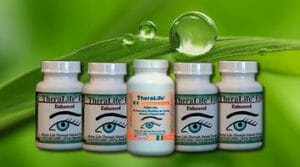Why do you care about Eye Health
Are your eyes especially dry throughout the day? Have you noticed a change in your eyesight that has come with age? The reality for seniors is that it is entirely common to experience trouble with the eyes and eyesight as time goes on. For most eye conditions, the probability of diagnosis increases at age 70 and even more at age 80. Eye health remains essential to keep in top shape.
As seniors, it can be difficult to motivate one’s self to do as much as possible for one’s health while staying calm and relaxed. With an eye condition, which can stem from other senior health issues like cardiovascular disease and diabetes, one’s mobility and overall well-being can be negatively affected, increasing levels of anxiety at the same time. So why not make it easy on yourself and do what you can to improve your eye health?
Risk Factors to Optimal Eye Health
Besides aging, which is the most important risk factor to eye health, there are numerous other factors for seniors that may cause dry eyes or a loss of vision, including:
- Computer and video game usage – Spending time in front a screen decreases the production rate of tears and the rate of blinking–both important bodily functions that, if altered, will negatively affect the eyes.
- Medications – Unfortunately, many medications seniors are required to take can also affect vision and eye dryness. Speak with your doctor if you find this to be true of a medication you take.
- Disease – Certain diseases, especially autoimmune diseases like Sjogren’s or lupus, are said to cause issues with the eyes. Try treating your disease by eating raw fruits and vegetables and see if the symptoms are reduced.
- Stress – Many seniors face the symptoms of stress due to a variety of changes in their habits and routines that come with age, and this can affect one’s overall eye health by altering the body’s normal functions.
If you find any of these risk factors affecting you and your eyes on a regular basis, you should seek alternative methods of medication, exercise, and diet to better maintain your optimal health.
Lifestyle Changes You Can Make to Promote Eye Health
Luckily, there are several easy changes seniors can make to help their eye health. Protecting the eyes from ultraviolet light by wearing sunglasses or brimmed hats is key to spending time outdoors. Making dietary changes, like eating more leafy greens, fruits, and raw foods is said to reduce the symptoms of most diseases and ailments, including dry eyes. Also, do not smoke. Studies in smoking and eye health show that the risk of developing cataracts is doubled if you smoke. Try also to incorporate a number of destressing techniques into your life to keep the body functioning at its best.
By keeping all of these positive changes in mind, we can do our part in maintaining our health in old age by learning habits that can help us to treat our eyes and to find more holistic ways to improve our vision.
How TheraLIfe can help
TheraLIfe has all natural products to help you improve eye health.
To learn more how TheralIfe Eye capsules work.
- 1.
- The Royal College of Ophthalmologists. Cataract Surgery Guidelines. London: Scientific Department, Royal College of Ophthalmologists; 2010.
- 2.
- Knudtson MD, Klein BE, Klein R, Cruickshanks KJ, Lee KE. Age-related eye disease, quality of life, and functional activity. Arch Ophthalmol 2005;123:807–14. 10.1001/archopht.123.6.807.
- 3.
- Lee PP, Cunningham WE, Nakazono TT, Hays RD. Associations of eye diseases and symptoms with self-reported physical and mental health. Am J Ophthalmol 2009;148:804–8. 10.1016/j.ajo.2009.06.021.
- 4.
- Harwood RH, Foss AJ, Osborn F, Gregson RM, Zaman A, Masud T. Falls and health status in elderly women following first eye cataract surgery: a randomised controlled trial. Br J Ophthalmol 2005;89:53–9. 10.1136/bjo.2004.049478. [
- 5.
- Mennemeyer ST, Owsley C, McGwin G. Reducing older driver vehicle collisions via earlier cataract surgery. Accid Anal Prev 2013;61:203–11. 10.1016/j.aap.2013.01.002.
- 6.
- Prokofyeva E, Wegener A, Zrenner E. Cataract prevalence and prevention in Europe: a literature review. Acta Ophthalmol 2013;91:395–405. 10.1111/j.1755-3768.2012.02444.x.
- 7.
- Edward S. Harkness Eye Institute. Digital Reference of Opthalmology. Airiani S, Braunstein RE, Chang S, Barile G, Cheung P, Florakis GJ, et al. , editors. New York, NY: Edward S Harkness Eye Institute, Columbia Presbyterian Medical Center; 2003.
- 8.
- American Academy of Ophthalmology. Cataract in the Adult Eye. Preferred Practice Pattern Guidelines. URL: http://one
.aao.org/CE /PracticeGuidelines/PPP_Content .aspx?cid =a80a87ce-9042–4677–85d7–4b876deed276 (accessed 29 August 2013). - 9.
- National Institute for Health and Care Excellence. Clinical Knowledge Summaries: Cataracts. URL: http://cks
.nice.org.uk/cataracts#azTab (accessed 29 August 2013). - 10.
- Pseudovs K, Elliott DB. Cataract morphology, classification, assessment and referral. CE Optometry 2001;42:55–60.
- 11.
- Sparrow JM, Frost NA, Pantilidis E, Laidlaw DAH. Decimalizartion of the Oxford Clinical Cataract Classification and Grading System: approach and performance. Ophthalmic Epidemiol 2000;7:49–60. 10.1076/0928-6586(200003)7:1;1-2;FT049. [
- 12.
- Chylack LT, Wolfe JK, Singer DM, Leske MC, Bullimore MA, Bailey IL, et al. The lens opacities classification system III. Arch Ophthalmol 1993;111:831–6. 10.1001/archopht.1993.01090060119035.
- 13.
- 14.
- Minassian DC, Reidy A, Desai P, Farrow S, Vafidis G, MInassian A. The deficit in cataract surgery in England and Wales and the escalating problem of visual impairment: epidemiological modelling of the population dynamics of cataract. Br J Ophthalmol 2000;84:4–8. 10.1136/bjo.84.1.4.
- 15.
- Frost A, Hopper C, Frankel S, Peters TJ, Durant J, Sparrow J. The population requirement for cataract extraction: a cross-sectional study. Eye 2001;15:745–52. 10.1038/eye.2001.242.
- 16.
- Royal National Institute of Blind People. Surgery deferred. Sight Denied. Variation in Cataract Surgery Provision Across England. RNIB Campaign Report, July 2013. London: Royal National Institute for Blind People; 2013.
- 17.
- Evans JR, Fletcher AE, Wormald RP. MRC trial of assessment and management of older people in the community. Causes of visual impairment in people aged 75 years and older in Britain: an add-on study to the MRC Trial of Assessment and Management of Older People in the Community. Br J Ophthalmol 2004;88:365–70. 10.1136/bjo.2003.019927.
- 18.
- Jefferis JM, Taylor J-P, Collerton J, Jagger C, Kingston A, Davies K, et al. The association between diagnosed glaucoma and cataract and cognitive performance in very old people: cross-sectional findings from the Newcastle 85+ study. Ophthalmic Epidemiol 2013;20:82–8. 10.3109/09286586.2012.757626. [
- 19.
- Koo E, Chang JR, Agrón E, Clemons TE, Sperduto RD, Ferris FL, et al. Ten-year incidence rates of age-related cataract in the Age-Related Eye Disease Study (AREDS): AREDS Report No. 33. Ophthalmic Epidemiol 2013;20:71–81. 10.3109/09286586.2012.759598.
- 20.
- Jaycock P, Johnston RL, Taylor H, Adams M, Tole DM, Galloway P, et al. The Cataract National Dataset electronic multi-centre audit of 55,567 operations: updating benchmark standards of care in the United Kingdom and internationally. Eye 2009;23:38–49. 10.1038/sj.eye.6703015.
- 21.
- Hammond CJ, Duncan DD, Snieder H, de Lange M, West SK, Spector TD, et al. The heritability of age-related cataract: the twin eye study. Invest Ophthalmol Vis Sci 2001;42:601–5.
- 22.
- Appleby PN, Allen NE, Key TJ. Diet, vegetarianism and cataract risk. Am J Clin Nutr 2011;93:1128–35. 10.3945/ajcn.110.004028.
- 23.
- Asbell PA, Dualan I, Mindel J, Brocks D, Ahmad M, Epstein S. Age-related cataract. Lancet 2005;365:599–609. 10.1016/S0140-6736(05)17911-2.
- 24.
- Ainsbury EA, Bouffler SD, Dorr W, Graw J, Muirhead CR, Edwards AA, et al. Radiation cataractogenesis: a review of recent studies. Radiation Res 2009;172:1–9. 10.1667/RR1688.1.
- 25.
- McCarty CA, Taylor HR. A review of the epidemiologic evidence linking ultraviolet radiation and cataracts. Dev Ophthalmol 2002;35:21–31. 10.1159/000060807.
- 26.
- Rosser DA, Laidlaw DA, Murdoch IE. The development of a ‘reduced logMAR’ visual acuity chart for use in routine clinical practice. Br J Ophthalmol 2001;85:432–6. 10.1136/bjo.85.4.432.
- 27.
- Bailey IL, Lovie-Kitchin JE. Visual acuity testing: from the laboratory to the clinic. Vision Res 2013;90:2–9. 10.1016/j.visres.2013.05.004.
- 28.
- Department of Work and Pensions: Registration of Blindness/Partially Sighted. URL: www
.dwp.gov.uk/publications /specialist-guides /medical-conditions /a-z-of-medical-conditions /vision/reg-blind-partial-sight-vision.shtml (accessed 29 August 2013). - 29.
- Holladay JT. Proper method for calculating average visual acuity. J Refract Surg 1997;13:388–91.
- 30.
- Rosser DA, Cousens SN, Murdoch IE, Fitzke FW, Laidlaw DAH. How sensitive to clinical change are ETDRS logMAR visual acuity measurements? Invest Ophthalmol Vis Sci 2003;44:3278–81. 10.1167/iovs.02-1100.
- 31.
- Schneck ME, Haegerstrõm-Portnoy G, Lott LA, Brabyn JA. Monocular vs. binocular measurement of spatial vision in elders. Optom Vis Sci 2010;87:526–31. 10.1097/OPX.0b013e3181e61a88.
- 32.
- Charalampidou S, Loughman J, Nolan J, Stack J, Cassidy L, Pesudovs K, et al. Prognostic indicators and outcome measures for surgical removal of symptomatic nonadvanced cataract. Arch Ophthalmol 2011;129:1155–61. 10.1001/archophthalmol.2011.111.
- 33.
- Mäntyjärvi M, Laitinen T. Normal values for the Pelli–Robson contrast sensitivity test. J Cataract Refrac Surg 2001;27:261–6. 10.1016/S0886-3350(00)00562-9.
- 34.
- Rubin GS, West SK, Muñoz B, Bandeen-Roche K, Zeger S, Schein O, et al. A comparative assessment of visual impairment in a population of older Americans: The SEE Study. Invest Ophthalmol Vis Sci 1997;38:557–68.
- 35.
- Rubin GS, Bandeen-Roche K, Huang G-H, Muñoz B, Schein OD, Fried LP, et al. The association of multiple visual impairments with self-reported visual disability: SEE Project. Invest Ophthalmol Vis Sci 2001;42:64–72.
- 36.
- Rabin J. Two eyes are better than one: binocular enhancement in the contrast domain. Ophthalmic Physiol Opt 1995;15:45–8. 10.1046/j.1475-1313.1995.9592791.x.
- 37.
- Cheng Y, Shi X, Cao XG, Li XX, Bao YZ. Correlation between contrast sensitivity and the lens opacities classification system III in age-related nuclear and cortical cataracts. Chinese Med J 2013;126:1430–5.
- 38.
- Pardhan S, Gilchrist J. The importance of measuring binocular contrast sensitivity in unilateral cataract. Eye 2013;5:35. [PubMed]
- 39.
- Elliott D, Hurst M, Weatherill J. Comparing tests of visual function in cataract with the patient’s perceived visual disability. Eye 1990;4:712–17. 10.1038/eye.1990.100.
- 40.
- Datta S, Foss AJ, Grainge MJ, Gregson RM, Zaman A, Masud T, et al. The importance of acuity, stereopsis, and contrast sensitivity for health-related quality of life in elderly women with cataracts. Invest Ophthalmol Vis Sci 2008;49:1–6. 10.1167/iovs.06-1073.





